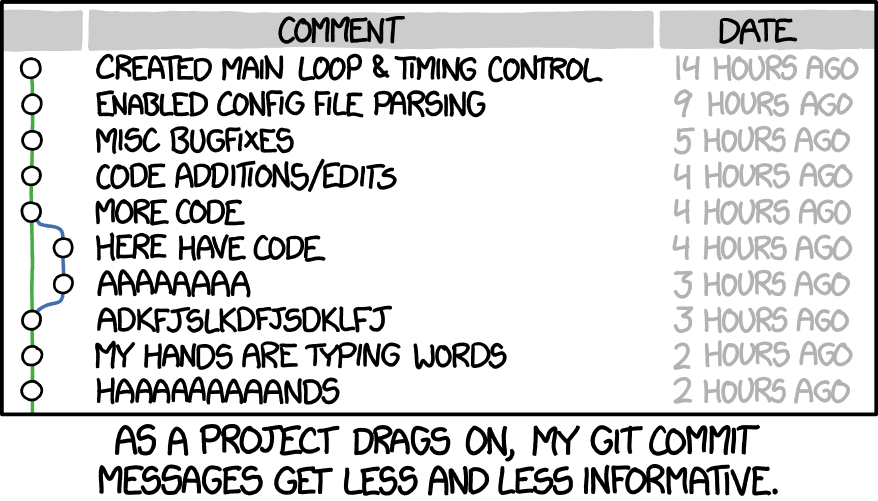
Git commits by xkcd
Even though there’s no correct answer to writing a commit message, there are principles to follow to make the commit messages more clear and readable, and people will really appreciate the effort put into making it nicer when tracing a bug or trouble shooting.
A good commit message
A good commit message should look like this:
JIRA-101 feat: add a new icon to home page
- add icon
- update CSS styling to accommodate the new icon
Co-authored-by: Bob <bob@example.com>The commit message can be broken down to the following parts:
<ticket-number> <semantic-tag>: <commit-message>
- <description1>
- <description2>
Co-authored-by: <participant1>
Co-authored-by: <participant2>- Ticket number gives clear indication what issue or feature it relates to.
- Semantic tag is used to summarise the purpose of the commit.
- Commit message is a detailed but brief message on what has been done in the commit.
- Participants is normally used in a paring/mobbing session.
If this makes sense straight away, then you are good to go. But if you want more theory backing, carry on reading and I will do my best to explain.
Small commits
You may be wondering why including semantic tag is a good idea. In order to understand why, let’s establish that small commits are more welcomed for the following reasons:
- it gives clear indication of your thought process during development
- it helps readers/reviewers understand clearly what each commit does
- it is easier to cherry pick commits if needed
- it makes revert/rollback of certain changes easier, without having to undo all the work
Semantic tag
On top of small commits, semantic tag is a crutch to help you identify what can go in as one commit. You can use the following principles to decide what semantic tag is the most appropriate:
feat: new featuresfix: bug fixesdocs: documentationstyle: formatting, styling, anything that does not change functionalities of production coderefactor: refactoring production codetest: test related commits, including refactors, but not style relatedchore: update build script, configuration, anything that does not change functionalities of production code
Commit message
There are also a few guidelines to follow when writing a commit message body:
- Start the commit message with a verb in present tense and be brief and concise
- Limit your self to writing less than 50 characters for the commit message, and less than 70 characters in commit message body, check out this 50/72 rule
- When pairing/mobbing, put the anticipants name and emails in the commit message body
These principles can optimise how commits look in GitHub, and the more you use it, you will find it a massive help to team collaboration.
Happy days!